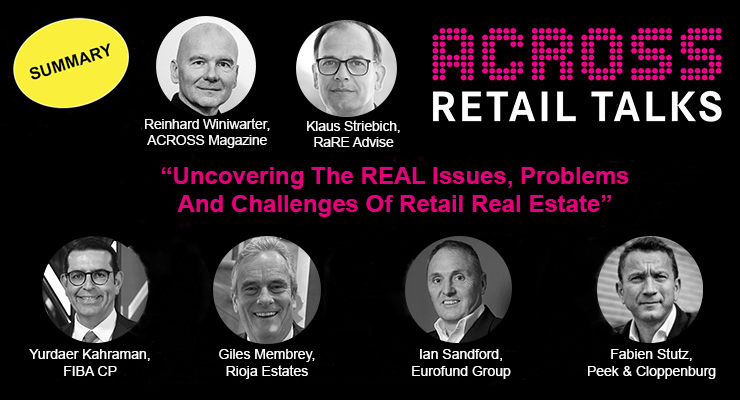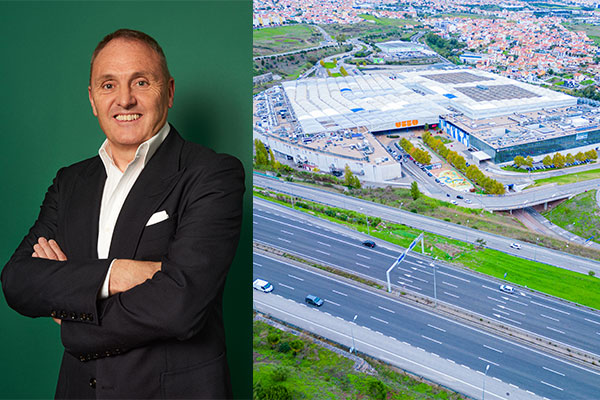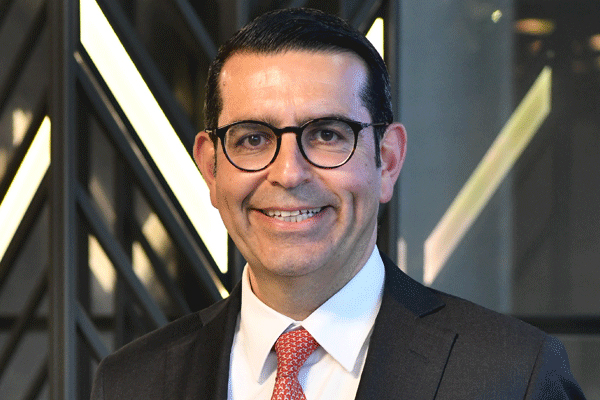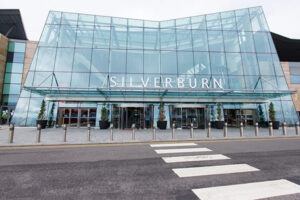ACROSS focuses on current industry topics in its regular Retail Talks. In this edition, moderator Klaus Striebich (RaRE Advise) and Reinhard Winiwarter (ACROSS Magazine) discussed together with fellow industry experts where the issues that most need to be addressed lie, and what the potential solutions involve.
The discussants of this episode were:
- Yurdaer Kahraman, CEO of FIBA Commercial Properties
- Giles Membrey, Managing Director of Rioja Estates
- Ian Sandford, Chairman at Eurofund Group
- Fabien Stutz, Director Real Estate & Construction at Peek & Cloppenburg

Recommendations for the industry
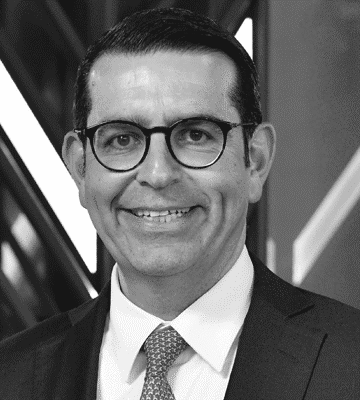
Kahraman: „Look for companies where the top decision-makers have a clear vision and strategy for the future to work with. Also, try to keep competition very close, and never underestimate developments. Last but not least, think clearly about the effect of online retail on the industry, and how stationary retail can reinvent itself.”

Sandford: “Focus on the guest and guest journey online and offline. Also, in the current retail environment, being bold and taking risks are values to embrace.”

Stutz: “The world is changing at a fast pace so being agile is crucial. Also, don’t be afraid of implementing a trial-and-error strategy on a regular basis, and do not forget to adapt.”

Membrey: “As a developer, there are vital criteria that need to be considered before deciding for a location as an outlet, such as catchment area, travelling distance, and also sustainability, which is becoming ever more important in the development of outlet centers, and not just based on the green credentials but also on the social values. Also, there is much more to a successful outlet center than just offering value goods. Finally, the overall experience, which already starts when the guest leaves their home, is key.”
Missing Skills The Industry Requires To Overcome The Current Challenges
Ian Sandford, Chairman of Eurofund Group argues that “we are missing leadership, courage and speed in the industry. Many who are coming from a development background have a decisive advantage when it comes to managing risks, and this skill base can be directly applied to asset management. Similarly, transformation and adaptability in retail are necessary factors as they also involve taking risks, yet, it is something that asset managers usually do not want to do.”
“Moreover, courage is also necessary in the current market environment, Sandford adds. As a fitting analogy, take the example of a goldfish, which, after going around its bowl once, already forgets about what it has done. The philosophy of letting go of what has happened and moving on is something that the retail industry truly needs to utilize. However, we react to new developments by staying close to our comfort zones, which eventually become our shells, so when something goes wrong while experimenting with new concepts and ideas we can always run back to square one. As such behavior lacks courage, it will ultimately limit us from discovering new, and different approaches that could lead to success. In general, retail experts tend to look inwards, whereas we should be looking outward and at other industries to see what we can learn from them.”
Fabien Stutz, Director Real Estate & Construction at Peek & Cloppenburg Austria, states that the pace of adaptation in retail is indeed slow. “Today, the retail market is moving faster than ever, and we need to adapt to the consumer demand and behavior that, in turn, also changes quickly. If you want to succeed you need to be more agile. Many retailers do this successfully on a weekly basis, but we are still far from being aligned with the speed of operation for operators and investors, where operators often adapt over a 5-6-month period, and investors over a 12-month period. Even though each player has a different aim and vision, as of now, the industry has still not managed to stay consistent in coordinating its adaptation speed.”
Giles Membrey, Managing Director of Rioja Estates, agrees with Sandford and argues that from the viewpoint of the outlet industry, it is all about risk management. “As a developer, I have noticed that quite often the decision-making process is not working adequately. Take for example developers’ tendency to try and get brands to commit to pre-letting at a location that could possibly open two years out. Some brands still take too much time to make such decisions, which, in turn, makes it difficult for developers to coordinate between brand and investors who usually want to see a location 40-50% pre-leased. In this case, reaching an optimal alignment between the two sides is the key to success.”
Ian Sandford and Yurdaer Kahraman pick up on many points they discussed with ACROSS in their recent interviews. Make sure to learn more about their insights, and how they navigate in the current market environment:
The Ideal Offer To Answer Customer Demand
Yurdaer Kahraman, CEO and Board Member of FIBA Commercial Properties, argues that “it is important to calculate the changing consumer behavior into the process of making investments. For example, a few years ago, 50-60% of the offer at FIBA malls in China was still made up of fashion retailers, whereas it has become much more diverse today, offering F&B, health, leisure and edutainment. If the aim is to increase dwell-time, appealing to families is another necessary step, and having a diverse offer is the best approach. A new segment they have at the mall in China is having EV car dealers as tenants. “With many of the new concepts being able to influence customer behavior – another good example is Miniso – retailers need to stay close to, and closely follow the retail market and our partners at all times. As online and offline retail are more relevant today than ever, what keeps us in the market is finding the proper symbiosis between online and offline, and to achieve that we have to make good use of customer data. Simply recreating a tailor-made product that was successful in the past will not suffice, we need to utilize technology to its fullest to be able to keep customers engaged with and invested in our offers. To overcome challenges, we need to have a clear vision and the required level of innovativeness.”
Sandford coined a new term, and sees shopping centers as ‘shopping resorts’, while also differentiating between clients, guests and customers. He prefers not only using the term ‘shopping resort’ over center but also ‘guest’ over ‘customer’. The primary reason for people visiting centers was to purchase, he explains, but since the purpose of the location has changed and been further refined, visitors are now looking for places to spend time at, and it is much more accurate to define these locations as resorts. “A recent survey we conducted among our guests showed that the number one reason for visiting our location is to spend time with their close friends and families, and that says a lot about the changing consumer behavior.” He argues that the retail industry can only continue to move forward by starting to realize the true value of hospitality.
Stutz very much agrees with Sandford’s view on the value of guests, because retailers can mainly attract guests by providing a unique experience, and as a retailer he appreciates that landlords and operators start to identify retailers as providers of hospitality services. “We need something that is consistent between retailer, operator, landlord and investor, and can be the key behind every decision, and shopping experience is the obvious answer. Our role is to keep our store and offer up to date and attract as many guests as possible so that we can combine the experience-based visit with commerce.”
Membrey adds, “for the past 20 years, the outlet industry has already seen its customers as guests, and the brands as customers, and – with the help of this differentiation – has achieved a much more collaborative approach to operating an outlet center. He also agrees with Sandford’s conclusion on current consumer behavior and has also observed that customers do not simply want to buy goods anymore, they want an immersive, personalized experience that makes buying fun and memorable, and outlets have led the way on that. Even the previous lack of F&B offers at outlets has changed in the past years, and improved significantly, to at least 10-20% of the occupied floor space, or more, depending on the location and culture.”
What Discounters Mean For The Strategic Positioning Of A Mall
Kahraman is of the opinion that “it depends on the geographic area. In Western-Europe oftentimes there are many high-streets which are highly frequented in contrast to some centers. Even though the first two floors of a center were working as intended there were still many empty spaces. Furthermore, some landlords’ choices when trying to fill these empty spaces were compromised to the degree that they had a bad impact on the malls. Too many discounters have decreased the value of some of the real estate assets, as they mainly bring short-term profit for the location.”
Sandford, in contrast, is of a slightly different opinion, as he argues that it all depends on the location and ‘base product’. “In some of Eurofund’s centers, the approaches to make them successful were quite different. Whereas in one case, the competition has made it impossible for the center to become successful by inviting big brands, e.g. from the Inditex Group, so Eurofund chose to lease to retailers, and leisure operators cost-effectively to make it work, in another case, owing to a lack of competitors, they were filling up a center with major brands and came to define it as the leading retail destination in the region.”
Key takeaways
- For the retail industry to successfully tackle many of its current problems, it first needs to address what it is currently lacking in terms of management.
- The huge difference in speed in the decision-making process of brands, landlords, and investors greatly reduces the overall adaptability and response time of a center to the quickly changing consumer behavior.
- Visitors no longer frequent retail destinations because they simply want to purchase goods. As such, operators and landlords need to be able to reinvent the locations to appeal to the current consumer demand.
- The industry needs to be agile, and have the courage to take risks.
Watch the whole Retail Talk here:
